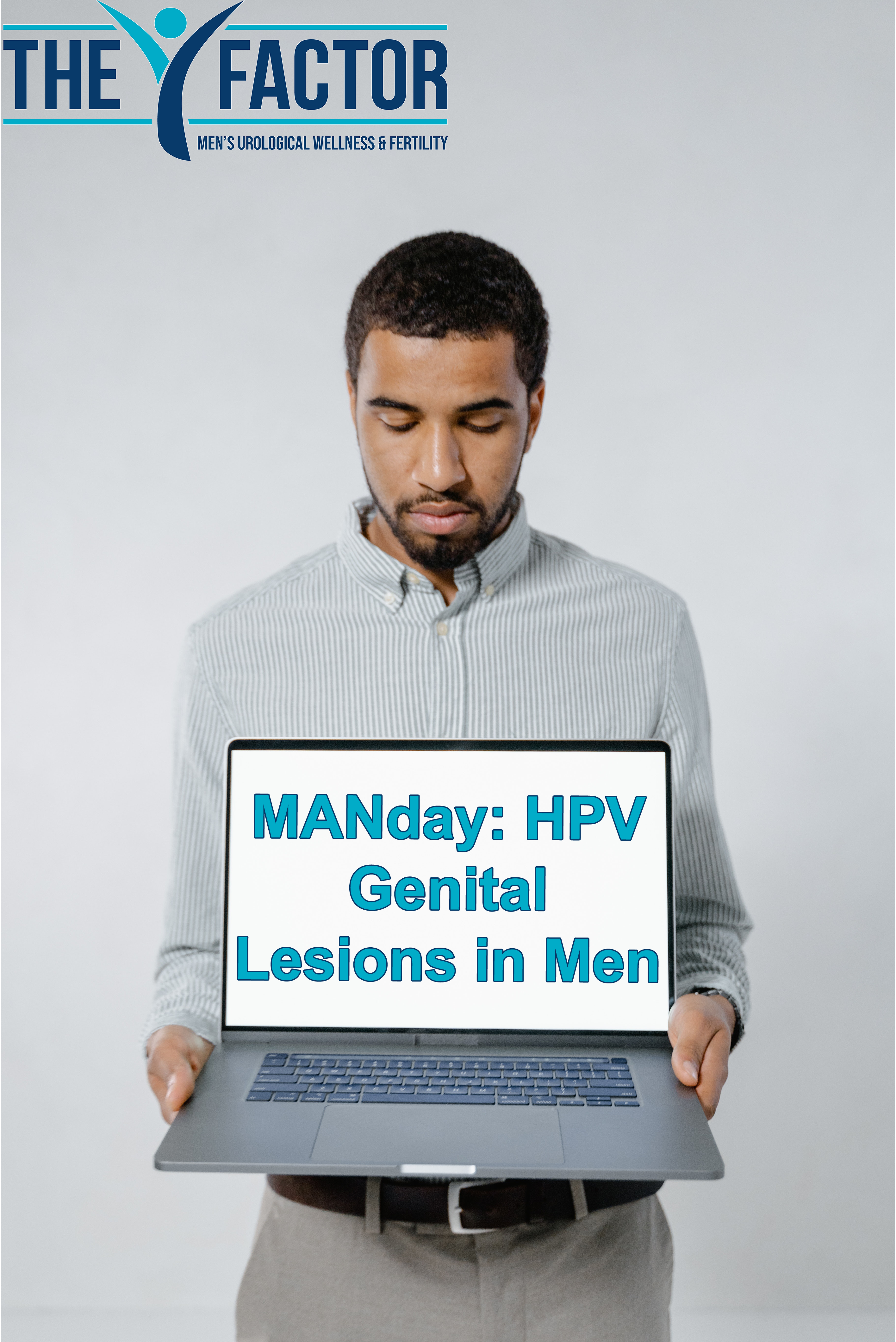MANday: HPV Genital Lesions in Men
What are they?
Genital lesions or genital warts are a common type of sexually transmitted infection (STI) that are usually caused by the human papillomavirus (HPV). There are more than 150 HPV strains that have been identified. Approximately 40 types are known to infect the genital area and these strains are further subdivided into low-risk (6, 11, 42, 43, 44) and high-risk (16, 18, 31, 33, 35, 39, 45, 52, 55, 56, and 58). The difference between high and low risk strains is the associated risk of them developing into cancer. Low risk strains have a low potential for oncogenesis. The strains that most often cause lesions are strains 6 and 11.
Peak incidence of this type of infection usually occurs between the ages of 16 to 25 but it can occur at any age. The lesions look like cauliflower fleshy pimples that sometimes merge into larger plaques. They can range in size from a few millimeters to several centimeters and may be located in the anogenital area or genital area; especially in areas of high friction. In males this usually involves the glans penis, prepuce (foreskin), shaft, and scrotum, but it can also involve the urethra and anal canal. They can vary in color from whitish to flesh color to hyperpigmented or even erythematous (redness). Other than being visible, they are usually painless and do not cause any other symptoms, but they can sometimes be painful, itchy, or friable (easily tear or bleed).
How do they occur?
Infection of HPV usually occurs through direct contact with individuals that have clinical (visible) or subclinical (not severe enough to be visible) HPV lesion. Infections can also occur from direct contact with contaminated surfaces or objects. The lesions can also be self-transferred from one area of the body to another. The HPV virus targets basal keratinocytes. These are cells located on the underlayer of the skin. The virus cannot easily gain entry to these cells due to an overlying layer of skin cells that create a protective barrier but it is theorized that trauma, abrasion, maceration, or microdefects in the skin can disrupt this protective barrier and allow the virus entry.
After the virus gains entry, it goes through a period of replication until it eventually migrates up the layers and develops into a visible clinical lesion. Lesions typically appear within weeks to months after exposure to HPV. The immune system is primarily responsible for controlling the HPV infection and in most healthy individuals the infection is spontaneously cleared and it is estimated that 10%-30% of genital lesions resolve in 3 months of onset without treatment.
Some strong risk factors that can lead to HPV infection include: intercourse at an early age, increase number of sexual partners, increase sexual contact with partners that have had high numbers of sexual partners, or being immunocompromised.
How are they diagnosed?
Diagnosis is usually made based on clinical presentation alone. Biopsy is generally not needed to diagnose HPV lesions but it is sometimes utilized if there is any ulceration of the lesions or if they are larger than 1 cm. The biopsy sample can also be sent to pathology to determine if it is of the high or low risks strains. External lesions can be diagnosed using direct visualization with a light and sometimes magnification. Internal lesions, such as in the male urethra, can cause changes in the flow of the urinary stream and may need to be diagnosed with the aid of a cystoscope.
How are they treated?
Being that in most cases they may resolve on their own, treatment is not always indicated. Some treatment options include topical agents such as creams or gels that can be self-applied; cryotherapy or trichloroacetic acid applied by the provider; or surgical excision which can eliminate the lesion in a single visit. Treatment can be challenging and recurrences are common. The type of treatment is dependent on many factors such as size, location, response to previous treatments, desire for self-administration versus provider-administration, cost, coexisting medical conditions, and provider experience. In general, the goal of treatment is to remove or destroy visible lesions.
How to prevent them?
The only way to completely prevent HPV infection is by practicing abstinence and avoiding contact with contaminated surfaces or objects. Condoms may help reduce the risk but are not 100% effective. There is also a vaccine available for the prevention of certain strains of HPV infection.
Differential diagnosis?
There are many other types of lesions or warts that mimic HPV lesions. Some examples include: condyloma latum – a type of lesion related to syphilis; molluscum contagiosum – a viral infection of the epidermis; pearly penile papules – a normal anatomic variant of the glans; seborrheic keratosis – a common noncancerous skin growth; carcinoma in situ – a type of cancer that can be confirmed with biopsy; sebaceous cysts – noncancerous cyst; or skin tags – noncancerous skin growths.
If you are concerned about any type of genital lesion or wart and want to be evaluated, please schedule an appointment with us at one of our five locations across the greater Houston area. We will evaluate it and help you determine what it may be and what is the best treatment option recommended for you.
References:
Bernard HU, Burk RD, Chen Z, et al. Classification of papillomaviruses (PVs) based on 189 PV types and proposal of taxonomic amendments. Virology. 2010 May 25;401(1):70-9.
Beutner KR, Reitano MV, Richwald GA, et al. External genital warts: report of the American Medical Association consensus conference. Clin Infect Dis. 1998 Oct;27(4):796-806.
Brown TJ, Yen-Moore A, Tyring SK. An overview of sexually transmitted diseases. Part II. Am Acad Dermatol. 1999 Nov;41(5 Pt 1):661-77.
Czelusta AJ, Evans T, Arany I, et al. A guide to immunotherapy of genital warts: focus on interferon and imiquimod. BioDrugs. 1999 May;11(5):319-32.
Handsfield HH. Clinical presentation and natural course of anogenital warts. Am J Med. 1997 May 5;102(5A):16-20.
Kirnbauer R, Lenz P, Okun MM. Human papillomavirus. In: Bolognia JL, Jorizzo JL, Rapini RP, eds. Dermatology Vol 1. London: Mosby; 2003:1217-33.
Mansur CP. Human papillomaviruses. In: Tyring SK, ed. Mucocutaneous manifestations of viral diseases. New York, NY: Marcel Dekker; 2002:247-94.
Severson J, Evans TY, Lee P, et al. Human papillomavirus infections: epidemiology, pathogenesis, and therapy. J Cutan Med Surg. 2001 Jan-Feb;5(1):43-60.
Workowski KA, Bolan GA; Centers for Disease Control and Prevention. Sexually transmitted diseases treatment guidelines, 2015. MMWR Recomm Rep. 2015 Jun 5;64(RR-03):1-137.
Benancio Martinez Jr is a certified Family Nurse Practitioner and one of the newest integral parts of the Y Factor team. Benancio is the medical provider in charge of the Northpointe location and brings to the Y Factor 10 years of nursing experience obtained through the emergency departments of the VA and Kingwood medical centers, as well as clinical experience in family practice, hematology, and oncology.
Want more information?
Ready to schedule you appointment? Just click on the call us button below to speak directly with our team.


